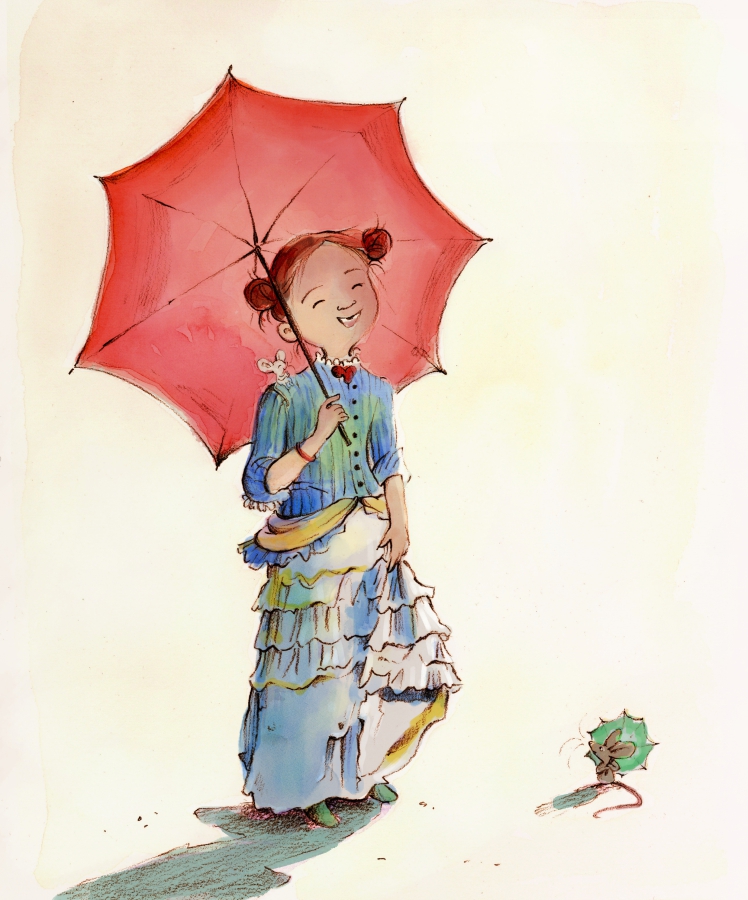

My Changes:
Made the woman a young girl, altered her expression, and brightened the colors.
Things I thought/Questions I asked:
In Bracquemond’s original, the woman has quite the mysterious expression. I don’t know what she’s thinking. I figured a young girl would probably be happy to go outside, hence the more jovial expression. Where is she going? And is anyone with her?
What I noticed or learned from Bracquemond’s techniques:
I love the way Bracquemond implies ruffles and stripes without overdoing it and tried to incorporate a little of that into my iteration. I also really enjoy how she uses a melding of colors and that simple background. The colors in her original are quite muted. In my research, I found that Bracquemond wanted a greater intensity of colors in her work. Several years after painting Woman with an Umbrella, she met Paul Gauguin who taught her how to prepare her canvas to allow brighter colors to emerge. Hopefully the more saturated colors I’ve used honor what she would have preferred.
Bracquemond’s artistic life is tragic, as her teachers led her to believe that women didn’t have the courage and perseverance to succeed. Her husband (a well-known painter) was purportedly jealous of her work, and never showed it to their friends or complimented her in front of other people. (Grrr!!!) Saddest of all, she eventually quit . . .

My Changes:
Brightened the color palette, including the mother’s dress—which pushed me to invent the way it’s constructed.
Things I thought/Questions I asked:
As the western hemisphere warms up, I thought Morisot’s piece was a fun way to celebrate. And what a beautiful city to look out on! I love the mood and think the addition of flowers in the top right adds a little extra life. I have to say it’s hard to tell what kind of relationship this mother and daughter have. In the original, the mother looks lost in thought (is she mourning?), her daughter perhaps unnaturally somber. I opted to add a slight smile to the mother. I hope in real life they frequently visited beautiful places and enjoyed their time together!
What I noticed or learned from Morisot’s techniques:
Although I didn’t fully capture it, I so admire Morisot’s grungy brush strokes. I’m also fond of her subject matter and the way she shows realistic anatomy. The tilt of the little girl’s head in the original is one of my favorite parts (and something I didn’t quite capture). Morisot’s decision to use a black dress is also quite striking.
For this MousterWork I wanted to work more traditional materials into the illustration, as encouraged by a current mentor. So I used different paper and pencils and pulled out my watercolors. It took a while to figure out how to merge the traditional work with my digital manipulations, but after several iterations I was finally happy with the result. (Whew!)

My Changes:
Brightened and altered the color in some places and added in a couple characters to comfort her. I also thought Hicks’ way of painting the shawl looked a lot like feathers, so I increased their visibility.
Things I thought/Questions I asked:
Is this sad little girl in her house? Does anyone else know what happened? How old is she? What does she do each day? work? go to school? have friends? Was this her pet? Based on the setting and her tattered clothing, her family is obviously not well off. I absolutely love how Hicks painted her expression and I’m frustrated I was unable to fully capture the innocence.
What I noticed or learned from Hicks’s techniques:
The emotion of this painting spoke to me immediately. I love that she’s sad, but it’s a complicated sadness: she isn’t crying, and her features aren’t especially emotional. But the slump of her shoulders, the distant sadness in her eyes, and her tender hands give us all the information we need. And the glowing luminescence of her face is so beautiful. Also, if you look carefully you’ll notice that the first focal point is her face, then her hands that lead to the bird.
I didn’t think this painting would take long since there are only two characters (well, five in mine), but it’s a deceptively complicated painting with so much detail in the stone, woodwork, clothing, and hair. I definitely could have spent several more hours (or days!) to give this MousterWork the full depth and beauty of the original.

My Changes:
Made it more colorful and added in a storyline.
Things I thought/Questions I asked:
As a piano player (and teacher) myself, I wanted to find out more about the virginal—that mini piano this young woman is playing. I learned that the instrument is part of the harpsichord family with the same mechanics and sound. The one pictured here looks even smaller than what I found online, so I wonder if there were different sizes for beginners and more advanced players? My husband also says size might have also had something to do with price range. I love how ornamental it is. And since I’m a huge fan of music from the Baroque period (probably my favorite music), it would be fascinating to go back in time when the music felt fresh and exciting.
Historians believe the pictured musician is Caterina’s sister. Did she like to play, or was it something her parents made her do? Is this just practice or an actual performance? Did she have favorite songs or composers (my Baroque favorites are Corelli, Vivaldi, and Bach)? What else did she like to do?
What I noticed or learned from Hemessen’s techniques:
Caterina’s realistic technique is wonderful, and she’s got the chiaroscuro down pat. That velvet dress sure feels velvety, and the intricate details of the virginal are featured beautifully. But what I like most might be how she painted the hands.
I learned that Caterina was the first known female Flemish painter. She studied art with her dad—making the requirements for aspiring painters less awkward, since they needed to live with their teachers for several years and study nude male figures (well, that part was probably still awkward). After marriage, Caterina’s career sadly ended—but she does have a bit of fame claim in that she’s the first painter on record to portray themselves working at the easel. If you’d like see that painting and read a recent in-depth interpretation about the portrait, click here.

When I was little, Mom and I often looked through a beautiful book of Masterpieces. I asked lots of questions about these people painted in time: How were we the same? How were we different? If you are also a fan of masterpieces, children’s book art, and searching for mice, I invite you to follow along!
All original images © Angela C. Hawkins


Love a MousterWork print? They will be available in my Etsy shop. Don’t see the one you want? Email me and I’ll add it in.